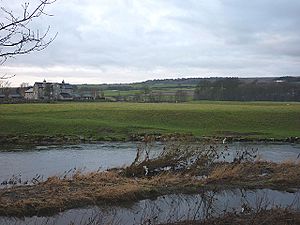Alavana facts for kids

Alavana was a name that people thought might belong to a Roman fort near Kendal in Cumbria, England. This fort is located at a place called Watercrook, about 2 miles (3.2 km) south of Kendal. However, the Roman name Medibogdo actually fits the fort's location much better because it sits on a bend in the river.
Contents
The Roman Fort at Watercrook
The Roman fort at Watercrook was first built around 90 AD. At that time, it was made mostly of wood. About 40 years later, around 130 AD, during the time of Emperor Hadrian, the fort was rebuilt using strong stone.
Changes Over Time
The fort was left empty for about 20 years. This happened when the Romans moved their soldiers further north to occupy Scotland, building the Antonine Wall. Later, under Emperor Marcus Aurelius, the fort was fixed up and used again. Roman soldiers stayed there until about 270 AD, when they finally left.
What's Left Today
Today, most of the old Roman fort is buried under a farm. But some interesting items found during digs are now on display. You can see these ancient artifacts at the Kendal Museum.
Alone: A Nearby Settlement
The name Alone likely belonged to a civilian settlement. This was a town or village where ordinary people lived, probably near Kendal. Roman travel guides, like the Antonine Itinerary, mentioned Alone. It was said to be 18 Roman miles from Galava and 19 Roman miles from Calacum.
Understanding "Alauna"
The name Alone is a different way of spelling Alauna. This was a very common name in ancient Britain and Europe. It was often used for rivers first, and then for the forts or settlements built along those rivers. Because it was used so much, figuring out exactly where all these places were and how their names were spelled in old writings can be tricky.
See also
 In Spanish: Alavana para niños
In Spanish: Alavana para niños

